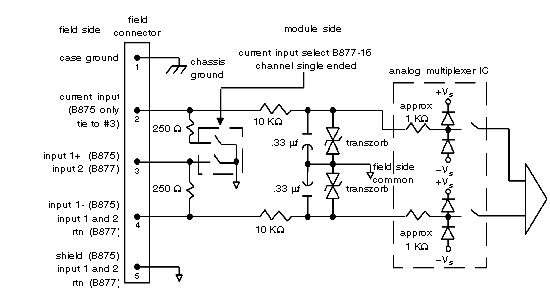The B875–111 analog-to-digital (A/D) input module (B875) converts input voltage and/or input current ranges into binary data. This module can be configured to accept 8 differential or 16 single ended inputs. When selected for 8 differential inputs, the card is called a B875–111. When selected for 16 single ended inputs, the card is called a B877–111. Refer to the simplified schematic below.
The B875 analog input module allows the polling of a wide array of field devices requiring different voltages and different currents based upon a unique application. One can select from five available input voltage ranges on a module-wide basis. The ranges, which are 0 to 5 V, 1 to 5 V, --5 to 5 V, 0 to 10 V, and -10 to 10 V, are selected by means of four DIP switches on the module configuration switch.
One can select from three available input current ranges, which are 0 to 20 mA, 4 to 20 mA, and -20 to +20 mA.
One can select from four available output formats. The formats, which are standard, elevated, full resolution, and decimal, are selected by means of two DIP switches on the module configuration switch.
One can select either no averaging, or 8, 16, or 32 sample inputs to be averaged to generate each output by means of two DIP switches on the module configuration switch.
The module has eight/sixteen analog inputs and is capable of updates to all channels every 10—20 msecs. The greater than 12-bit resolution and the absolute accuracy of 0.1% at 0—60° C provides precise control of the application.
The following illustration represents the simplified schematic diagram for the B875–111 module.
B875–111 Analog input module, simplified schematic diagram
